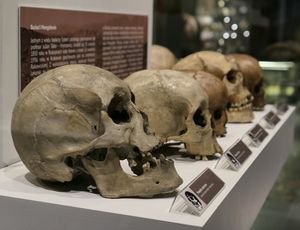
The anthropological collections located in the Nature Education Centre of the Jagiellonian University were gathered from the second half of the 19th century and come from different parts of the world, including Europe, Asia, Africa and South America, covering ages and eras from the Neolithic period to the present day.
Initially, they were located in the now defunct Anthropological Museum, which was founded in the early 20th century by Professor Izydor Kopernicki, and operated throughout the entirety of the 20th century at the Department of Anthropology of the Jagiellonian University. At that time, the collection was curated directly by the Head of the Department of Anthropology of the Jagiellonian University.
The craniological collections were mainly made up of donations from researchers and travellers, including Professor Julian Talko-Hryncewicz, Bronisław Piłsudski, Professor Benedykt Dybowski and Professor Stanisław Szolc-Rogoziński. The most important collections include a series of Krakow skulls (from the Wawel Castle, Szczepański Square, Ariański Square, Wszystkich Świętych Square and Św. Floriana Square), as well as Finnish, Mongolian and Buryat skulls, Ainan skulls, which are a unique exhibit worldwide, along with Siberian and African skulls. A significant number of exhibits have been acquired through exchanges between various anthropological centres around the world or purchased by the managers of the Department of Anthropology. In the aftermath of World War II, such practices became impossible. Moreover, many osteological materials come from archaeological surveys, among others from Łany Wielkie, Lubsko, Wawrzeńczyce, Krosno Odrzańskie, Sanok, and Książnice Wielkie.
These days, the most interesting exhibits are presented in the Anthropological Block, which is a part of the permanent exhibition entitled “The Evolution of the Earth and Life”, located on the first floor of the building. The entirety of the collection is located in the NEC warehouses.
Undoubtedly, one of the most crucial parts of the exhibition is made up of replicas of Hominidae bone remains, purchased thanks to the funding provided by the European Union. The collection includes, among others, a replica of the skull and bone pelvis of the famous “Lucy”, who represents the Australopithecus afarensis, as well as replicas of skulls representing Australopithecus africanus, Paranthropus boisei, Homo habilis, Homo ergaster, Homo erectus and Homo neanderthalensis. Another interesting part of the exhibition is a diorama with prepared specimens of ape and monkeys, along with a reconstruction of a representative of the already extinct Plesiadapis species. The most interesting exhibits include natural mummies from Poland and Lithuania, as well as Egyptian man-made mummies. Skulls with intentional deformations, brought from Bolivia and Peru, as well as a skull with an execution nail from the Middle Ages, also evoke emotional responses of the visitors.
Bones with pathological changes constitute another important part of the exhibition. It includes both skulls and elements of the postcranial skeleton with mechanical injuries (various fractures, wounds inflicted with sharp or blunt objects, skulls with post-trepanation holes), bones with traces of infectious diseases and cancers, as well as inflammatory changes or developmental disorders.
